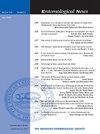土耳其湖区谷物区囊翅目物种多样性的现状与未来
IF 0.3
4区 农林科学
Q4 ENTOMOLOGY
引用次数: 0
摘要
摘要:本研究于2016年和2017年对土耳其湖区谷物产区的蓟马区系进行了实地调查。采用灭杀法和击杀法,在生产季节各产区分穗前和穗后2期采集蜱类标本。根据形态分类特征对蓟马标本进行鉴定。通过计算物种分布图、物种丰富度、丰度、Shannon-Wiener (H’)指数、物种季节性动态和物种性别比等指标来反映湖区囊翅目物种的多样性。计算Pearson相关系数,评价了飞蛾物种丰富度与寄主植物丰富度的相关性。采用物种分布建模(MaxEnt)算法,建立了本研究区所收集的囊翅目物种的当前和未来分布格局。在两年的研究中,在小麦、燕麦和大麦生产田中采集了27603只囊翅目昆虫标本。共有4科51种。小麦单倍蓟马(haplothrip tritici)数量最多,共采集标本15284份,占总数的55.371%。在Thripidae科中,相对丰度最高的是地中海蓟马(collebolothrips mediterraneus)、马蹄铁蓟马(Chirothrips manicatus)、马蹄铁蓟马(Thrips angusticeps)、黑蓟马(Thrips herricki)和禾蓟马(Limothrips ceralium)。考虑到研究区海拔梯度,物种丰富度和丰度最高的区域为950 ~ 1050 m.a.s.l,记录物种40种,标本7622件。囊翅目潜在物种丰富度的增加主要集中在布尔杜尔省东部和伊斯帕塔省中北部地区。本文章由计算机程序翻译,如有差异,请以英文原文为准。
Current and Future Diversity of Thysanoptera Species in the Cereal Areas of the Lakes Region, Turkey
ABSTRACT: Field surveys were carried out to determine the thrips fauna in cereal production areas of the Lakes Region in Turkey in 2016 and 2017. Thysanoptera specimens were collected with destructive and strike methods in two periods (before and after spike) from each production field during the production season. Thrips specimens were identified based on morphological taxonomic characters. Species distribution maps, species richness, abundance, as well as Shannon–Wiener (H') index, species seasonal dynamic and species sex ratio were calculated to indicate the diversity of Thysanoptera species in the Lakes Region. We also calculated Pearson correlation coefficient to evaluate correlation between Thysanoptera species richness and host plant richness. Species Distribution Modelling, namely MaxEnt algorithm, was used in order to establish the current and future distributional patterns of Thysanoptera species collected in our research area. During the two years of the study, 27,603 specimens of Thysanoptera were collected in production fields of wheat, oat and barley. There were 51 different species from four families. Haplothrips tritici was the most abundant species with 15,284 specimens or 55.371% of all collected. The highest relative abundance within family Thripidae was recorded for Collembolothrips mediterraneus, Chirothrips manicatus, Thrips angusticeps, Thrips herricki and Limothrips cerealium. Considering the altitudinal gradient of the study area, the highest species richness and abundance were found between 950 and 1,050 m.a.s.l. with 40 species and 7,622 specimens recorded. Potential species richness of Thysanoptera revealed an increase in areas that predominantly encompass eastern parts of Burdur province, as well as central north parts of Isparta.
求助全文
通过发布文献求助,成功后即可免费获取论文全文。
去求助
来源期刊

Entomological News
生物-昆虫学
CiteScore
1.10
自引率
25.00%
发文量
17
期刊介绍:
Contributions are accepted on any of the aspects of systematics and taxonomy of insects. This includes: taxonomic revisions, phylogenetics, biogeography and faunistics, and descriptive morphology of insects. Taxonomic papers describing single species are acceptable if such a study is sufficiently justified, however, comprehensive studies that provide a comparative, integrated study of insect systematics and taxonomy will get priority.
 求助内容:
求助内容: 应助结果提醒方式:
应助结果提醒方式:


